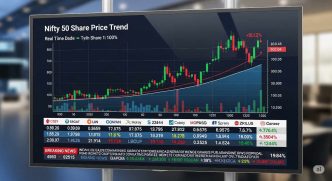Types of Mutual Fund investment in 2025
Debt Funds
Ideal for low-risk investors. In 2025, dynamic bond funds are gaining traction due to interest rate fluctuations.
- Credit quality (AAA rated bonds preferred)
- Duration (shorter duration reduces volatility)
Multi-Asset Funds
These funds invest across equity, debt, and gold, giving natural diversification.Example: Quant Multi Asset Fund
International Funds
Let you invest in global opportunities like the US Tech sector or Global Healthcare.
Performance Table
| Fund Type | 2023 Return | 5-Yr CAGR |
|---|---|---|
| Large Cap | 18.2% | 14.1% |
| Small Cap | 34.7% | 21.3% |
| Banking Sector | 28.4% | 17.9% |
How to Start Investing in Mutual Funds in 2025
Complete KYC
KYC can be done online via video call in less than 10 minutes. Only Aadhaar and PAN needed.
Choose the Right Platform
| Feature | Groww | Zerodha Coin |
|---|---|---|
| UI | Beginner | Technical |
| Direct Funds | Yes | Yes |
| Research Tools | Basic | Advanced |
Step-by-Step Process
- Set a goal (e.g., ₹50 lakh in 15 years)
- Assess your risk profile (conservative, moderate, aggressive)
- Choose suitable funds (start with hybrid or index funds)
- Set up SIP and automate it
Common Mistakes to Avoid in 2025
Chasing Last Year’s Winners
A fund that performed well last year might not perform the same in 2025. Check long-term consistency.
Ignoring Taxation
- Debt Fund STCG: Taxed as per slab
- Equity LTCG: 10% above ₹1 lakh after 1 year
Switching Funds Too Frequently
Frequent fund switching leads to extra exit load and tax. Prefer funds with churn ratio <30%.

Mutual Fund Taxation in 2025
Tax Rules Summary
| Investment Type | Less Than 1 Yr | More Than 1 Yr |
|---|---|---|
| Equity Funds | 15% STCG | 10% LTCG over ₹1 lakh |
| Debt Funds | As per slab | As per slab (indexation removed) |
Tax-Saving Options
- ELSS Funds: Eligible for ₹1.5 lakh deduction under Section 80C
- NPS: Extra ₹50,000 under 80CCD(1B)
- Health Insurance: Deduction under 80D
Tools and Resources
- Groww App: For investing and tracking
- Zerodha Coin: Direct fund investment
- Smallcase: Thematic portfolios
- AMFI India: Fund comparison and calculators
- Trendlyne: Mutual fund manager performance
Portfolio Building Strategy
Age-Based Allocation
| Age Group | Equity | Debt |
|---|---|---|
| 20s | 80% | 20% |
| 40s | 60% | 40% |
| 60s | 30% | 70% |
Satellite Strategy
- Core (60%): Index and Large Cap Funds
- Satellite (40%): Sectoral and thematic bets
Rebalancing: After every 6–12 months or major market changes.
Strategy Examples
The ₹1 Crore Goal
SIP ₹20,000/month in flexi-cap fund at 13% CAGR = ₹1.02 crore in 15 years.
Add bonuses or Lumpsum on market dips to accelerate goal
Retirement Planning Strategy
Age 30–50: Small & Mid Cap focus
Age 50–60: Balanced Advantage or Hybrid Funds
Post 60: Systematic Withdrawal from Debt Funds
FAQ: Mutual fund investment
1. Minimum to start?
Start with just ₹100 using fractional SIPs.
2. SIP or Lumpsum — which is better?
SIP is safer for regular investing; lumpsum suits market dips.
3. Are returns taxable?
Yes. Equity: 10% tax on gains over ₹1L; Debt: taxed as per income slab.
4. Safest mutual fund?
Debt funds like Liquid or Overnight Funds.
5. Can I stop SIP anytime?
Yes, SIPs are flexible — pause, edit, or stop anytime.
Conclusion
The mutual fund industry in 2025 is more accessible, flexible, and innovative than ever. Investors can benefit from:mutual fund investment
- AI-managed and thematic funds
- Low-cost direct plans
- Fractional and automated SIPs
Key Takeaways:
- Start early and invest consistently
- Don’t chase returns, focus on long-term
- Use SIPs for discipline and lumpsum during corrections
- Stay tax-efficient with ELSS and long-term planning
With the right strategy and patience, even a modest monthly investment can turn into a multi-crore corpus over time.
72292
Know more related :
India Stock Market Opening & Closing Timings Explained








